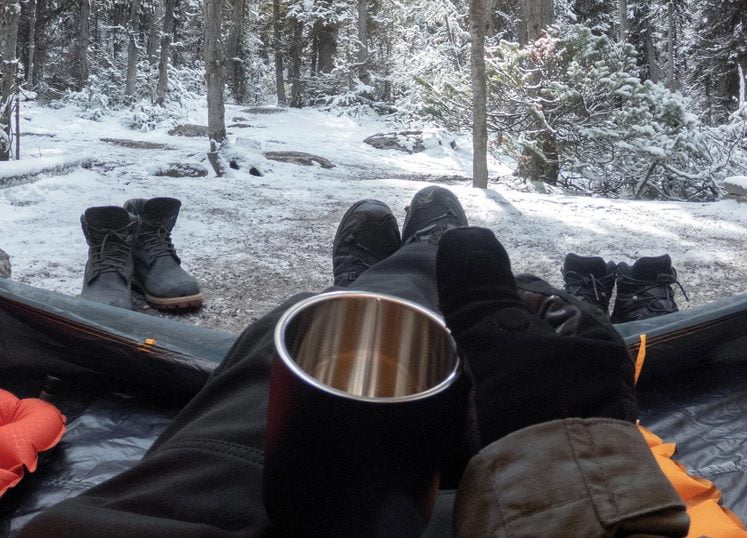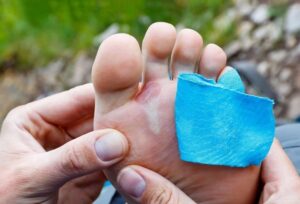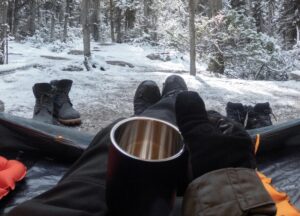
This winter and cold weather backpacking and camping checklist we’ve provided below can be very helpful to ensure your cold weather outdoor trips don’t turn into a miserable experience. Winter camping can be an incredibly rewarding experience, but it also comes with its own set of challenges. This in-depth guide covers everything you need to know to stay comfortable, safe, and have the adventure of a lifetime in cold conditions.
Gear You Need for Cold Weather Camping
Having the right clothing, sleep system, and camping gear is crucial for warmth and safety when camping in frigid temps. Here are some details on the key items we feel are must-haves when you head out:
Sleep System
Your sleep system is your refuge in cold and frigid weather and should be chosen carefully. Look for:
- Sleeping bag: Pick a bag rated for the coldest temperatures you expect to encounter. Down fill offers maximum warmth but avoid if wet conditions are likely. Synthetic fill performs when wet.
- Sleeping pad: Foam pads provide the most insulation from frozen ground. Pair with a self-inflating pad for comfort and warmth.
- Pillow: Inflatable pillows keep your head insulated from the cold.
- Liner: Silk or fleece liners add warmth and keep your bag clean.
Clothing and Footwear
Focus on moisture management and insulation power when choosing clothing:
- Base layers: Wool or synthetic long underwear helps regulate body temperature.
- Insulation layers: Fleece jackets, down coats, and puffy synthetics add warmth without bulk.
- Waterproof layers: Hard shells and waterproof pants prevent wind and water intrusion.
- Hand and footwear: Mittens are warmer than gloves. Wear thick wool socks and insulated, waterproof boots. Thick wool socks from Darn Tough or Smartwool are great options.
Hydration and Food
Proper hydration and nutrition provides energy and prevents dehydration:
- Water: Insulated bottles prevent freezing. Sleep with bottles to keep from freezing overnight. Make sure the lid/cap is tight! Leaking water on sleeping gear and cold weather don’t mix well.
- Food: Pack high-calorie foods like nuts, chocolate, and cheese for quick energy. Also choose dense dehydrated food meals and backpacking/hiking bars.
- Stove and fuel: Liquid fuel stoves perform better in frigid temps. Small canister stoves are easier to use. If it’s windy, a small windshield will be optimal to retain as much direct heat to your pot/cup and also help to heat up water faster.
Shelter and Sleep Accessories
Stay dry and block the elements with a durable cold weather shelter:
- Tent: Choose a 3 or 4 season tent with aluminum poles and stakeout points. Dome-style sheds snow well.
- Sleeping pad: Closed cell foam pads insulate from frozen ground. Inflatables add comfort.
- Pillow: Inflatable models provide insulation for your head.
Since a sleeping pad with an R rating for temperatures you’re sleeping in is crucial for retaining heat if you’re a “ground dweller,” here is a great chart of R rating values for sleeping pads:
| R-VALUE | FAHRENHEIT | CELSIUS |
|---|---|---|
| 1.0 | 50° F | 10.0° C |
| 1.5 | 45.0° F | 4.5° C |
| 2.0 | 40° F | -1.0° C |
| 2.5 | 35.0° F | -6.5° C |
| 3.0 | 30° F | -12.0° C |
| 3.5 | 25.0° F | -17.5° C |
| 4.0 | 20° F | -23.0° C |
| 4.5 | 15.0° F | -28.5° C |
| 5.0 | 10° F | -34.0° C |
| 5.5 | 5.0° F | -39.5° C |
| 6.0 | 0° F | -45.0° C |
| 6.5 | -5.0° F | -50.5° C |
| 7.0 | -10° F | -56.0° C |
| 7.5 | -15.0° F | -61.5° C |
| 8.0 | -20° F | -67.0° C |
| 8.5 | -25.0° F | -72.5° C |
| 9.0 | -30° F | -78.0° C |
| 10.0 | -40° F | -89.0° C |
Tips and Tricks for Comfortable Winter Camping
Follow these expert tips to stay warmer and have a better experience:
- Check conditions and pack accordingly. Bring extra layers for changing weather.
- Clear snow and flatten your tent site if possible.
- Layer closed cell foam pad under your air mattress for insulation.
- Reduce space inside your tent by putting gear around the perimeter.
- Put a hot water bottle in your bag by your core, thighs or neck. Reheat it when it cools.
- Stash your boot liners at the bottom of your bag so they stay warm for the morning.
- Cinch your sleeping bag hood around your face while sleeping to keep warm air in.
- Eat a high calorie snack like chocolate or cheese before bed to give your body fuel.
- Use an insulated reusable straw instead of drinking straight from your bottle to prevent spills.
- In the morning, remove frost carefully with a brush before it can melt into your gear.
- Sip from insulated bottles to stay hydrated. Dehydration drops body temp.
- Protect electronics and batteries by sleeping with them in your bag. Cold drains batteries.
Setting Up Your Campsite for Warmth
Pick the right camp location and set it up properly to keep old air out:
- Find a relatively flat, dry area that is protected from the wind.
- Clear snow before setting up your tent if possible so cold air doesn’t rise from the bottom.
- Point the narrowest side of your tent into the wind to reduce surface area.
- Use sheltered areas like thick forests to block wind. Avoid open areas.
- Dig a shallow trough in the snow where you’ll sleep so you don’t roll around.
- Place gear bags around the inside perimeter of your tent to block wind.
- Make a wind break using snow, rocks, or forest debris if needed.
Sleep Warm Through the Night
Getting quality rest is crucial. Here are tips for staying cozy in your sleeping bag:
- Cinch down the hood with only a small breathing hole. Your exhaled moisture can condense and make insulation wet.
- Wear synthetic or wool long underwear, hat and gloves to bed. No cotton!
- Use a vapor barrier like a trash bag if moisture is an issue.
- If you feel cold, do a few minutes of exercises like push-ups to get blood flowing before jumping in your bag.
- Eat a high-calorie food like chocolate before bed to give your body fuel to burn.
- Place a hot water bottle by your core, thighs or neck for quick warmth.
- Add a sleeping pad under your bag for insulation from frozen ground.
Safety: Prevent Hypothermia and Frostbite
Don’t let cold weather injuries cut your adventure short. Know how to recognize issues and respond:
Signs of Hypothermia:
- Uncontrollable shivering
- Slurred speech
- Poor coordination
- Confusion and memory loss
- Slow or irregular pulse and breathing
- Loss of consciousness
Frostbite Warning Signs:
- Numbness and tingling
- Pale, waxy-looking skin
- Firm or waxy skin when pressed
- Lack of sensation in area
- Blisters or blackened skin in severe cases
First Aid Treatment:
- Get emergency help if severe
- Move person to warm area
- Remove any wet clothing
- Warm the body gradually with blankets, body heat
- Do not rub or massage affected areas
- Do not apply direct heat like hot water or fires
Additional Cold Weather Camping Tips
- Fill a spare stuff sack with crumpled newspaper and keep it in your sleeping bag as insulation.
- Invest in a sleeping bag waterproofing treatment to add water repellency and prevent moisture buildup.
- Make a drawstring closure on your sleeping bag hood using cord and mini cord locks to snug it tighter.
- Use a foam sit pad inside your tent as a welcome mat so you don’t track in snow.
- Wrap your tent exterior in an emergency space blanket for added insulation.
- Put chemical hand warmers inside your insulated water bottles to prevent freezing.
- Take 2 pairs of upper thermals to change into dry layers at night after sweaty activities.
- Use vapor barrier socks over regular socks to lock in warmth by blocking moisture.
- Pad your tent floor with pine needles or evergreen branches for extra insulation.
- Bring emergency items like extra blankets, hand warmers, and battery packs.
- Avoid camping alone in extreme cold. Partners can assist if issues arise.
- Research the area and educate yourself on potential risks and conditions.
- Tell someone your plans and expected return time in case of emergency.
- Plan activities to keep moving and generate warmth during the day.
Stay warm and be prepared using this complete guide to cold weather camping. The right gear, preparation and knowledge will ensure you have an amazing experience in the beauty of winter!





